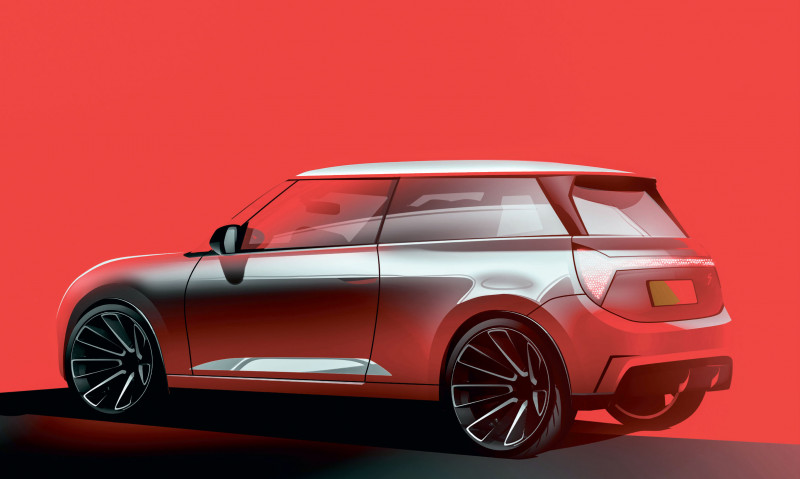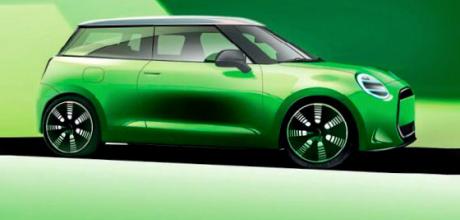Five new Minis Next-gen 3dr, 5dr, cabrio, two SUVs
Next-generation hatchbackto lead Mini’s future line-up. New 3dr will get petrol and electric power; new 5dr, convertible and SUV pair due.
SCOOP 5 ALL-NEW MINIS
They’ve even shrunk the hatch
FIVE NEW MINIS, INCLUDING A SMALLER HATCH
Mini has confirmed plans for a dramatically revamped range comprising separate petrol and electric versions of its three-door flagship, a small electric crossover and a larger Countryman SUV. Autocar joined Mini for a round of winter testing in a development prototype of the upcoming electric hatchback, where the company confirmed that over the next five years, its model range will undergo rationalisation and a big push towards electric powertrains. The core of the range, as before, will be the classic three-door hatchback, but buyers will have a choice of two electric powertrains.

Radical redesign but familiar proportions for the next Mini
Unlike the current Mini Electric, which is based on a platform that wasn’t originally designed with electrification in mind, the new electric models will be mechanically unrelated to petrol-engined Minis.
However, they will continue to look very similar.
A longmooted city car that was set to take the Minor name back into production and serve as a rival to the Honda E is now off the table, Mini has confirmed. Ever since Mini revealed the much-loved Rocketman concept back in 2011, it has been speculated that a city car could be introduced to sit beneath the supermini.
Instead, Mini has now managed to make the core three-door hatchback slightly shorter. It will lose a chunk of its lengthy front overhang to bring the design closer to that of the Sir Alec Issigonis-designed original 1959 Mini and BMW’s 2000 revival. The wheelbase, meanwhile, will grow by around 40mm to boost interior space, and the track will be widened. Mini design boss Oliver Heilmer has previously said he is looking to “reduce Mini design as much as possible”, with the aim of taking out ornamental elements. As seen on the development prototype for the new three-door hatchback (see overleaf), flourishes such as the clamshell bonnet and black plastic wheelarch extensions will be dropped in line with this ethos.
The two-door convertible and the five-door hatchback will return too, with the latter’s design to “be much improved”, according to Heilmer. Both will remain petrol-only, however. For buyers after a more practical electric Mini, there will be a smaller crossover to sit beneath the Countryman, allowing that SUV to get larger (see separate story overleaf). The petrol three-door and five-door hatchbacks and the convertible will continue to be built at Mini’s Oxford plant, but the electric models will come out of a new factory in Zhangjiagang, China.
This new plant is the result of the Spotlight Automotive joint venture formed by Mini’s BMW Group parent firm and Chinese giant Great Wall Motor in 2018 for collaboration on the development and production of battery-electric vehicles. As a result, the petrol and electric Mini hatchbacks are based on completely different architectures. Having two separate platforms, says Mini, means the cars aren’t compromised like the current Electric, which can accommodate only a relatively small battery.
The petrol cars will be based on an evolution of the current FAAR platform, a larger variation of which is used by the new BMW 2 Series Active Tourer MPV and will go into the next BMW X1 and Mini Countryman SUVs. We expect a similar powertrain line-up to the current hatchback, with three-cylinder turbo petrol engines for the lower-powered One and Cooper models and four-cylinder turbo petrol units for the Cooper S and John Cooper Works hot hatches. Mild-hybrid assistance is likely, but plug-in hybrid powertrains have been ruled out, as have diesel engines. The electric hatchback, on the other hand, will be based on the EV-exclusive Spotlight platform.
Despite many components being sourced from Great Wall and the car being made in China, Mini is adamant that the development is all carried out in-house by Mini engineers. It said that its customers are demanding and would notice if it doesn’t feel like “a real Mini”. To that end, the new petrol and electric hatchbacks are being developed side by side, with engineers working on both.
Mini is gradually moving towards being an all-electric brand. It plans to launch its final ICE car in 2025 and for EVs to make up 50% of its global sales by 2027. As part of that plan, there will be more variety in the EV offering. Today’s Electric is positioned as the battery equivalent of the Cooper S, but for the next generation, there will be a dedicated electric Cooper model.
The battery size will be tied to the power output, so the 181bhp Cooper will have a battery capacity of approximately 40kWh. That is already a lot more than the current car’s usable capacity of 28.9kWh but still not huge by today’s standards; it is similar to that offered by the Fiat 500. As a result, it is projected to have a theoretical range of around 185 miles. The range-topping Cooper S, meanwhile, will come with 221bhp and a battery capacity of around 50kWh for a range of approximately 250 miles. Autocar understands that despite the bigger battery, the new electric hatchback will end up slightly lighter than the current Electric, thanks to the dedicated EV platform. In addition, it will benefit from a lower centre of gravity and slightly rearbiased weight distribution.
The suspension will retain the same layout: MacPherson struts at the front and a multilink system at the back. The latter is unique in this segment, with all other supermini-sized cars using a torsion beam. However, the engineers reckon that the added sophistication afforded by a multi-link defines the Mini’s character, making it worth the additional expense. The new car is currently about 18 months away from going into production. Over that time, it will go through an extensive verification programme of summer and winter testing, with set-up and the tuning of the control systems still to be finalised.
Mini is believed to be working on an even more powerful version of the electric Cooper S to carry the JCW performance brand into the electric era.
New Mini will be fourth since BMW revival of 2000. Five-door and convertible will stick with petrol.
Electric models will be mechanically unrelated to ICE Minis but still look very similar
Instead of a centre tunnel, the new car has a pair of rails that accommodate a series of accessories like cubbies and cupholders. The armrest is mounted to the seat.


